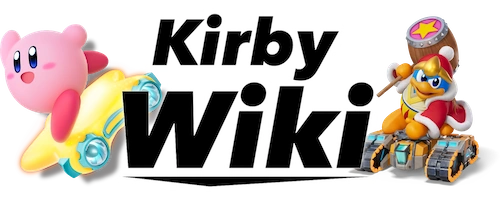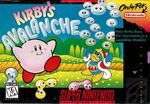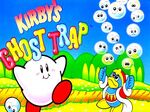mNo edit summary Tag: sourceedit |
(Note about Kirby's attitude) Tags: Visual edit apiedit |
||
| Line 27: | Line 27: | ||
In the game, as in all ''Puyo Puyo'' games, groups of two colored [[Blob]]s fall from the top of the screen. The player must rotate and move the groups before they touch the bottom of the screen or the pile, so that matching-colored Blobs touch from above, below, the left or the right. Once four or more same-colored Blobs touch, they will disappear, and any Blobs above them will fall down to fill in the space. If a player manages to set off a chain reaction with these Blobs, Boulders will fall on the other player's screen. The number of Boulders that falls depends on both the number of Blobs popped and the number of consecutive chain reactions. These Boulders will only disappear if a player manages to pop a group of Blobs that are in direct contact with the Boulders. |
In the game, as in all ''Puyo Puyo'' games, groups of two colored [[Blob]]s fall from the top of the screen. The player must rotate and move the groups before they touch the bottom of the screen or the pile, so that matching-colored Blobs touch from above, below, the left or the right. Once four or more same-colored Blobs touch, they will disappear, and any Blobs above them will fall down to fill in the space. If a player manages to set off a chain reaction with these Blobs, Boulders will fall on the other player's screen. The number of Boulders that falls depends on both the number of Blobs popped and the number of consecutive chain reactions. These Boulders will only disappear if a player manages to pop a group of Blobs that are in direct contact with the Boulders. |
||
| − | Notably, in the cinematics between each round, Kirby and the other characters are shown having conversations and trash-talking with each other in full sentences. This differs greatly from other ''Kirby'' games, where the cast hardly speaks at all. Kirby's personality in the game is completely different from every other game medium he appears in, as he is portrayed as much more sarcastic and confrontational than normal. |
+ | Notably, in the cinematics between each round, Kirby and the other characters are shown having conversations and trash-talking with each other in full sentences. This differs greatly from other ''Kirby'' games, where the cast hardly speaks at all. Kirby's personality in the game is completely different from every other game medium he appears in, as he is portrayed as much more sarcastic and confrontational than normal. Kirby may have been given this attitude to cater to the perceived tastes and character preferences of Western audiences, as the game was designed specifically for North American and European markets, and has never been released in Japan. |
==Stages== |
==Stages== |
||
Revision as of 04:42, 11 November 2016
| “ | In this puzzle game, Kirby stacked colorful falling Blobs. By strategically rotating and moving Blobs before they hit the pile, Kirby could destroy them and set off chain reactions. This game included two-player bouts and matches against many familiar faces from the Kirby universe. It's the only Kirby game that wasn't released in Japan.” |
| — Summary • Kirby's Dream Collection: Special Edition |
Kirby's Avalanche (Kirby's Ghost Trap in PAL regions) is a puzzle Kirby game for the Super Nintendo Entertainment System (SNES) that was originally released in Europe on February 1, 1995 and was later released in North America on April 25, 1995.
Kirby's Avalanche is an adaption of the Japanese puzzle game Puyo Puyo with characters from the Kirby series. It was developed by HAL Laboratory, Nintendo, and Compile and was released in 1995.
This game is a modification of Super Puyo Puyo; the characters and music of that game (with the exception of "Panic") are replaced with Kirby characters and songs. Super Puyo Puyo takes place in the Madō Monogatari universe. It was converted into a Kirby spin-off for its international releases. As a result, this game is not considered to be canonical.
Gameplay
In the game, as in all Puyo Puyo games, groups of two colored Blobs fall from the top of the screen. The player must rotate and move the groups before they touch the bottom of the screen or the pile, so that matching-colored Blobs touch from above, below, the left or the right. Once four or more same-colored Blobs touch, they will disappear, and any Blobs above them will fall down to fill in the space. If a player manages to set off a chain reaction with these Blobs, Boulders will fall on the other player's screen. The number of Boulders that falls depends on both the number of Blobs popped and the number of consecutive chain reactions. These Boulders will only disappear if a player manages to pop a group of Blobs that are in direct contact with the Boulders.
Notably, in the cinematics between each round, Kirby and the other characters are shown having conversations and trash-talking with each other in full sentences. This differs greatly from other Kirby games, where the cast hardly speaks at all. Kirby's personality in the game is completely different from every other game medium he appears in, as he is portrayed as much more sarcastic and confrontational than normal. Kirby may have been given this attitude to cater to the perceived tastes and character preferences of Western audiences, as the game was designed specifically for North American and European markets, and has never been released in Japan.
Stages
Beginners
- Practice 1: Waddle Dee (this is a training stage)
- Practice 2: Bronto Burt
- Practice 3: Waddle Doo
Normal
- Stage 1: Poppy Bros. Sr.
- Stage 2: Whispy Woods
- Stage 3: Kabu
Hard
- Stage 4: Broom Hatter
- Stage 5: Squishy
- Stage 6: Lololo & Lalala
- Stage 7: Bugzzy
- Stage 8: Paint Roller
Final
- Stage 9: Heavy Mole
- Stage 10: Mr. Shine & Mr. Bright
- Stage 11: Kracko
- Stage 12: Meta Knight
- Stage 13: King Dedede
Music
| Main article: Kirby's Avalanche/Music |
Trivia
- Some of the music from Kirby's Adventure are remixed for Kirby's Avalanche. Additionally, Bugzzy, Paint Roller, Heavy Mole, Mr. Shine & Mr. Bright, and Meta Knight all originated from Kirby's Adventure and appear in this game. Finally, the Fountain of Dreams reappears in this game with Nightmare's "Power Orb" form resting on it.
- This game was released for the SNES while Dr. Robotnik's Mean Bean Machine, another variation of Puyo Puyo, was released on Sega Genesis.
- This is the first game to call Meta Knight by his name in-game.
- This is also the first game in which Meta Knight uses his current design.
- Technically, this is also the first Kirby game to have voices, although the announcer is the only one who has voice acting.
- This is also the first game in which Kirby and King Dedede are shown to speak.
- All the bosses from Kirby's Dreamland and Kirby's Adventure return as opponents, with the exception of Kabula and Nightmare.
- On the box art, King Dedede is not wearing his gloves. In-game, however, he does wear them.
- Unlike all the other Kirby games, this game wasn't released in Japan.
- Kirby's Avalanche and Kirby Tilt 'n' Tumble are currently the only games that has an announcer announce the title on the title screen.












